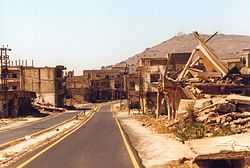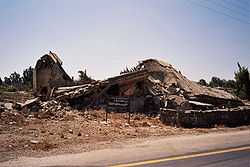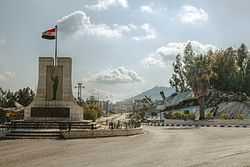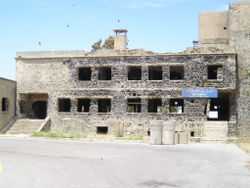Quneitra
| Quneitra القنيطرة | |
|---|---|
 | |
 Quneitra | |
| Coordinates: 33°07′N 35°49′E / 33.117°N 35.817°E | |
| Country |
|
| Governorate | Quneitra |
| District | Quneitra District |
| Region | Golan Heights |
| Settled | around AD 1000 |
| Destroyed | 1974 |
| Government | |
| • Governor | Nawaf Abboud al-Fares |
| Elevation[1] | 1,010 m (3,313 ft) |
| Population (2004 census[2]) | |
| • City | 153 |
| • Metro | 4,318 |
| Time zone | EET (UTC+2) |
| • Summer (DST) | EEST (UTC+3) |
| Area code(s) | 43 |
| Website | eQunaytra |
Quneitra (also Al Qunaytirah, Qunaitira, or Kuneitra; Arabic: القنيطرة al-Qunayṭrah) is the largely destroyed and abandoned capital of the Quneitra Governorate in south-western Syria. It is situated in a high valley in the Golan Heights at an elevation of 1,010 metres (3,313 feet)[1] above sea level. Quneitra was founded in the Ottoman era as a way station on the caravan route to Damascus and subsequently became a garrison town of some 20,000 people, strategically located near the ceasefire line with Israel. Its name is Arabic for "the little bridge".[3]
On 10 June 1967, the last day of the Six-Day War, Quneitra came under Israeli control.[4] It was briefly recaptured by Syria during the 1973 Yom Kippur War, but Israel regained control in its subsequent counter-offensive. The city was almost completely destroyed before the Israeli withdrawal in June 1974. It now lies in the demilitarized United Nations Disengagement Observer Force Zone between Syria and Israel, a short distance from the de facto border between the two countries, and is populated by only a handful of families. Syria refused to rebuild the city and actively discourages resettlement in the area. Israel was heavily criticized by the United Nations for the city's destruction,[5] while Israel has also criticized Syria for not rebuilding Quneitra.[6]
Political status
Quneitra is the capital of the Quneitra Governorate, a district of southwestern Syria that incorporates the whole of the Golan Heights. The city of Quneitra is within the portion of the Golan Heights controlled by Syria.[7]
Geography and demographics

Quneitra is situated in a high valley in the Golan Heights at an altitude of 942 m (3,091 ft) above sea level. It is overshadowed to the west by the Israeli-held portion of the Golan Heights and the peak of Har Bental. The surrounding area is dominated by ancient volcanic lava flows interspersed by a number of dormant volcanic cones which rise some 150–200 m (500–700 ft) above the surrounding plain. The volcanic hills of the region have played a key role as observation points and natural firing positions in the conflicts over the region, most notably in the Yom Kippur War.[8] In more peaceful times, the fertile volcanic soil has supported agricultural activities such as wheat growing and pastoralism.[1]
Writing during the inter-war period, the American traveller Harriet-Louise H. Patterson recorded that Quneitra was
charmingly set in a grove of eucalyptus trees. Its chief claim to charm or the few moments of a traveller's time beyond passport formalities is the beautiful vista which it offers of Jordan as it flows down from Hermon through banks of tangled bush and flowering pink and white oleanders. Kuneitra is pleasant as a stopping-place for lunch. It is cool under the spreading trees, usually quiet and restful.[9]
The city's position on an important trade route gave it a varied population for much of its history. By the start of the 20th century it was dominated by Muslim Circassians from the Caucasus. Its population grew to some 21,000 people, mostly Arabs, following Syrian independence from France in 1946.[7] After its abandonment in 1967 and subsequent destruction, its population was dispersed to other parts of Syria. The city remains abandoned apart from a residual Syrian security presence.
History
Early history
The surrounding area has been inhabited for millennia. Palaeolithic hunter-gatherers are thought to have lived there, as evidenced by the discovery of Levallois and Mousterian flint tools in the vicinity.[10] A settlement was established at least as early as Roman and Byzantine times, serving as a stop on the road from Damascus to western Palestine. Saint Paul is said to have passed through the settlement on his way from Jerusalem to Damascus. The site of the Conversion of Paul was traditionally identified with the small village of Kokab, north-east of Quneitra, on the road to Damascus.[11]
In 1868 a travel handbook reported that the site was a "ruined village of about 80 or 100 houses" and that a large khan also stood in ruins.[12]
The modern city grew in the later part of the 19th century around the nucleus the old Ottoman caravanserai, which had been built using the stones of a ruined ancient settlement.[13] In the mid-1880s, Quneitra was the main city and seat of government of the Jaulân.[14] Schmacher wrote that it "consists of 260 buildings, which are mostly well and carefully constructed of basalt stones, and contains, excluding the soldiers and officials, 1,300 inhabitants, principally Circassians."[14]
During World War I, the Australian Mounted Division and 5th Cavalry Division defeated the Ottoman Turks there on 29 September 1918, before they took Damascus [15] (see also Battle of Megiddo (1918)). Quneitra saw several battles during the Syria-Lebanon Campaign of Second World War, including the Battle of Damascus and Battle of Kissoué.[16]
Arab-Israeli conflict
When the modern states of Syria and Israel gained their independence from France and Britain respectively after the Second World War, Quneitra gained a new strategic significance as a key road junction some 15 miles (24 km) from the border. It became a prosperous market town and military garrison, with its population tripling to over 20,000 people, predominately Arabs.[7]
Six-Day War
Quneitra was the Syrian headquarters for the Golan Heights.[17] The Israeli capture of the city occurred in chaotic circumstances on 10 June 1967, the last day of the Six-Day War. Israeli forces advancing towards Quneitra from the north-west prompted Syrian troops to deploy north of the city, under heavy bombardment, to defend the road to Damascus. At 8:45 a.m., Syrian radio mistakenly broadcast an announcement that the city had fallen. Alarmed, the Syrian Army's redeployment turned into a chaotic retreat along the Damascus road.
According to 8th Brigade Commander Ibrahim Isma'il Khahya:
We received orders to block the roads leading to Quneitra. But then the fall of the city was announced and that caused many of my soldiers to leave the front and run back to Syria while the roads were still open. They piled onto vehicles. It further crushed our morale. I retreated before I ever saw an enemy soldier.[18]
Although a correction was broadcast two hours later, the Israelis took advantage of the confusion to seize Quneitra.[19] An armoured brigade under Colonel Albert Mandler entered Quneitra at 2:30 p.m. and found the city deserted and strewn with abandoned military equipment. One of the Israeli commanders later commented:
We arrived almost without hindrance to the gates of Quneitra ... All around us there were huge quantities of booty. Everything was in working order. Tanks with their engines still running, communication equipment still in operation had been abandoned. We captured Quneitra without a fight.[20]
Time magazine reported: "In an effort to pressure the United Nations into enforcing a ceasefire, Damascus Radio undercut its own army by broadcasting the fall of the city of El Quneitra three hours before it actually capitulated. That premature report of the surrender of their headquarters destroyed the morale of the Syrian troops left in the Golan area."[21]
A ceasefire was agreed later in the afternoon, leaving Quneitra under Israeli control. In June 1967, Time magazine reported: "The city of El Quneitra was a ghost town, its shops shuttered, its deserted streets patrolled by Israelis on house-to-house searches for caches of arms and ammunition. The hills echoed with explosions as Israeli sappers systematically destroyed the miniature Maginot line from which the Syrians had shelled kibbutzim across the Sea of Galilee."[22]
The United Nations Special Representative Nils-Göran Gussing visited it in July and reported that "nearly every shop and every house seemed to have been broken into and looted" and that some buildings had been set on fire after they had been stripped. Although Israeli spokesmen told Gussing that Quneitra had actually been looted by the withdrawing Syrians, the UN representative viewed this as unlikely given the extremely short space of time between the erroneous radio announcement and the fall of the city a few hours later. He concluded that "responsibility for this extensive looting of the town of Quneitra lay to a great extent with the Israeli forces."[23]
Israeli occupation
The deserted city remained in Israeli hands for the next six years. However, Israel and Syria remained in a state of war throughout this period (and, indeed, to the present day). The town gained a fresh symbolic value; it was seen by the Syrians as "the badge of Syria's defeat, an emblem of hatred between Syria and Israel and a cross [Syrian President Hafez al-Assad] had to bear."[24] Syria shelled the city several times during the early 1970s; in June 1970 a Syrian armored unit launched an attack,[25] and in November 1972, Damascus radio announced that Syrian artillery had again shelled Quneitra.[26]
Yom Kippur War

During the first few days of the Yom Kippur War in 1973, Quneitra was briefly recaptured by the Syrian Army before it was repulsed in an Israeli counter-offensive.[27] In the middle of October 1973 the Israeli counter-offensive started. The Syrians had massed nearly 1,000 tanks along a 60-mile front. With a massive concentration of tanks, the Israelis lashed into the Syrian forces. The Syrians at first fell back, but then managed to counterattack and drive back into occupied territory. Quneitra changed hands several times. Finally, Israeli armored units, closely supported by Phantoms and Skyhawks performing close air support with napalm strikes against the forward Syrian units, halted the Syrian drive and turned the Arabs back.[28]
Israeli control continued to hold the city until early June 1974, when it was returned to Syrian civilian control following the signature of a United States-brokered disengagement agreement signed on 31 May 1974. The surrender of Quneitra was controversial, with Israeli settlers[29] and the Likud and National Religious Party opposing it[30] and even establishing a settlement on its outskirts for a brief period (see Keshet). According to Michael Mandelbaum, The agreement provided that the city was to be repopulated to serve as evidence of peaceful Syrian intentions, by creating a hostage to Syrian good behaviour which would encourage the Israelis to pull back further.[31] The disengagement went into force on 6 June.[32] On 26 June, the Syrian president Hafez al-Assad travelled to Quneitra where he pledged to return the rest of the occupied territories to Syrian control.[33]
Return to Syrian control


Western reporters accompanied Syrian refugees returning to the city in early July 1974 and described what they saw on the ground. Time magazine's correspondent reported that "Most of its buildings are knocked flat, as though by dynamite, or pockmarked by shellfire." [34] Le Monde's Syria correspondent, in a report for The Times, gave a detailed eyewitness description of the destruction:
Today the city is unrecognisable. The houses with their roofs lying on the ground look like gravestones. Parts of the rubble are covered with fresh earth furrowed by bulldozer tracks. Everywhere there are fragments of furniture, discarded kitchen utensils, Hebrew newspapers dating from the first week of June; here a ripped-up mattress, there the springs of an old sofa. On the few sections of wall still standing, Hebrew inscriptions proclaim: "There'll be another round"; "You want Quneitra, you'll have it destroyed."[35]
The city had reportedly been systematically stripped by the Israeli forces,[7] with anything movable being removed and sold to Israeli contractors. The empty buildings were subsequently pulled apart with tractors and bulldozers.[36] Speculating on the possible reasons for the razing of the city, The Times' correspondent noted in 1974 that "the Israeli evacuation of Quneitra took place soon after the return of Israeli prisoners of war from Damascus with many stories of torture."[35]
Israel asserted that most of the damage had been caused in the two wars and during the artillery duels in between.[37][38] Several reports from before the withdrawal did refer to the city as "ruined" and "shell-scarred".[39][40][41] The Times' correspondent saw the city for himself on 6 May, a month before the Israeli withdrawal, and described it as being "in ruins and deserted after seven years of war and dereliction. It looks like a wild west city struck by an earthquake and if the Syrians get it back they will face a major feat of reconstruction. Nearly every building is heavily damaged and scores have collapsed."[29]
Direct evidence of the city's condition was provided when it was filmed on 12 May 1974 by a British television news team which included the veteran journalist Peter Snow, who was reporting for Independent Television News on the disengagement negotiations. His report was broadcast on ITN's News at Ten programme. According to The Times' correspondent Edward Mortimer, "viewers were thus afforded a panoramic view of the city, which had stood almost completely empty since the Syrian army evacuated it in 1967. It could be seen that many of the buildings were damaged, but most of them were still standing." After it was handed over, "very few buildings were left standing. Most of those destroyed did not present the jagged outline and random heaps of rubble usually produced by artillery or aerial bombardment. The roofs lay flat on the ground, 'pancaked' in a manner which I am told can only be achieved by systematic dynamiting of the support walls inside." Mortimer concluded that the footage "establishes beyond reasonable doubt that much of the destruction took place after 12 May—at a time when there was no fighting anywhere near Kuneitra."[42]
The United Nations established a Special Committee to Investigate Israeli Practices Affecting the Human Rights of the Population of the Occupied Territories, which concluded that Israeli forces had deliberately destroyed the city prior to their withdrawal. The report's conclusions were subsequently adopted by the United Nations General Assembly. It passed a resolution on 29 November 1974 describing the destruction of Quneitra as "a grave breach of the [Fourth] Geneva Convention" and "condemn[ing] Israel for such acts," by a margin of 93 votes to 8, with 74 abstentions.[5] The United Nations Commission on Human Rights also voted to condemn the "deliberate destruction and devastation" of Quneitra in a resolution of 22 February 1975, by a margin of 22 votes to one (the United States) with nine abstentions.[43]
The U.S. Committee for Refugees and Immigrants has reported that: "Before leaving, however, the Israelis leveled the city with bulldozers and dynamite."[44]
Today

As of 2012, the city remains destroyed. Syria has left the ruins in place and built a museum to memorialize its destruction. It maintains billboards at the ruins of many buildings and effectively preserves it in the condition that the Israeli army left it in. The former residents of the town have not returned and Syria discourages the re-population of the area.[19] However, in the 2004 census by the Central Bureau of Statistics, a small population of 153 people living in 28 households was recorded, all living in the neighborhood of Rasm al-Rawabi.[45] The Rough Guide to Syria describes the current appearance of the city: "The first sight of the flattened houses on Quneitra's outskirts is the most dramatic; many of the unscathed roofs simply lie on top of a mass of rubble, leaving the impression of a building that has imploded."[19]
The city has often been used as a stop for foreign VIPs, ranging from the Soviet foreign minister Alexei Kosygin in June 1976[46] to Pope John Paul II in May 2001.[47] Only a handful of families now live in the town, making a living by providing services for the United Nations troops patrolling the demilitarized zone.[48] According to The Times, "the carefully preserved ruined city has become a pilgrimage site for a generation of Syrians."[49]
The city can be visited by tourists, but a permit from the Syrian Ministry of the Interior is required, and sight-seeing is supervised by a military guide. The principal sights on the standard tour are the remains of Quneitra's hospital, mosque and Greek Orthodox church. A "Liberated Quneitra Museum", displaying artifacts from the city's ancient and medieval past, is housed in the former Ottoman caravanserai in the city centre. The western edge of the city marks the start of "no-man's land" beyond which lies Israeli-controlled territory. Because the border is closed, it is not possible to visit Quneitra from Israel.[50]
Syrian civil war
On 13 November 2012, during the ongoing Syrian civil war that began in March 2011, President Bashar al-Assad issued a decree to establish a branch of the University of Damascus in Quneitra.[51] On 6 June 2013, the nearby Quneitra border crossing was attacked by anti-government rebels and temporarily occupied. Government forces were able to quickly retake the crossing. A Filipino peacekeeper of the UNDOF was wounded during the fighting. As a result the Austrian government announced the withdrawal of its troops from the UN mission.[52][53] Rebels also attacked a military checkpoint in the town,[54] and by the next day were attacking several Syrian Army positions in Quneitra in a failed attempt to capture the city.[55]

See also
- Quneitra Crossing
- Shebaa Farms
- Syrian towns and villages depopulated in the Arab-Israeli conflict
Further reading
- Goren-Inbar, N., and Paul Goldberg. Quneitra: A Mousterian Site on the Golan Heights. Publications of the Institute of Archaeology, the Hebrew University of Jerusalem, 31. [Jerusalem]: Institute of Archaeology, Hebrew University of Jerusalem, 1990.
References
- ↑ 1.0 1.1 1.2 Geoffrey William Bromiley. "Golan", in International Standard Bible Encyclopedia: E-J, p. 520. Wm. B. Eerdmans Publishing, 1994. ISBN 0-8028-3782-4
- ↑ Quneitra city population
- ↑ http://www.syriagate.com/Syria/about/cities/Quneitra/
- ↑ On 10 June, Israeli authorities utilized a postmark, in Arabic, English and Hebrew, for mail sent from Quneitra. Livni, Israel. Encyclopedia of Israel Stamps. Tel Aviv: Sifriyat Ma'arit, 1969. p.195
- ↑ 5.0 5.1 "Report of the Special Committee to Investigate Israeli Practices Affecting the Human Rights of the Population of the Occupied Territories", United Nations General Assembly Resolution 3240, 29 November 1974, A/RES/3240, unispal.
- ↑ Abraham Rabinovich. The Yom Kippur War, 492. Knopf Publishing Group, 2005. ISBN 0-8052-1124-1
- ↑ 7.0 7.1 7.2 7.3 "Qunaytirah, Al-." Encyclopædia Britannica. 1993
- ↑ Simon Dunstan. The Yom Kippur War 1973: The Sinai, p. 9. Osprey Publishing, 2003. ISBN 1-84176-220-2
- ↑ Harriet-Louise H. Patterson, Around The Mediterranean With My Bible. W. A. Wilde Co., 1941
- ↑ Takeru Akazawa, Kenichi Aoki, Ofer Bar-Yosef, Neanderthals and Modern Humans in Western Asia, p. 154. Springer, 1998. ISBN 0-306-45924-8
- ↑ Ivan Mannheim, "Biblical Damascus", in Syria & Lebanon Handbook, p. 100. 2001, Footprint Travel Guides. ISBN 1-900949-90-3
- ↑ Porter, Josias Leslie. A handbook for travellers in Syria and Palestine, J. Murray, 1868, pg. 439. [Harvard University, 4 Jan 2007]
- ↑ Paul Virgil McCracken Flesher, Dan Urman, Ancient Synagogues: historical analysis and archaeological discovery, p. 394. Brill Academic Publishers, 1995. ISBN 90-04-11254-5
- ↑ 14.0 14.1 G. Schmacher (1888). The Jaulân. London: Richard Bentley and Son. pp. 207–214.
- ↑ "CAMPAIGN SUMMARY AND NOTES ON HORSE ARTILLERY IN SINAI AND PALESTINE" (PDF). Field Artillery Journal. MAY JUNE 1928.
- ↑ Compton Mackenzie (1951). Eastern Epic. London: Chatto & Windus. p. 605 pages.
- ↑ "A Campaign for the Books". Time Magazine. 1 September 1967.
- ↑ Oren, M., "Six Days of War", Ballantine Books, New York, 2002 (p301)
- ↑ 19.0 19.1 19.2 Andrew Beattie, Timothy Pepper, The Rough Guide to Syria 2nd edition, p. 146. Rough Guides, 2001. ISBN 1-85828-718-9
- ↑ Jeremy Bowen, Six Days: How the 1967 War Shaped the Middle East, p. 304. Simon & Schuster Ltd, 2003. ISBN 0-7432-3095-7
- ↑ "A Campaign for the Books". Time Magazine. September 1, 1967.
- ↑ "Coping with Victory". Time Magazine. 23 June 1967.
- ↑ Bowen, ibid.
- ↑ Seale, Patrick. (1988). Asad of Syria: The struggle for the Middle East (p. 141). Berkeley: University of California Press
- ↑ Charles Mohr (27 June 1970). "Israel and Syria battle third day in the Golan area". The New York Times.
- ↑ "Syria Shells Israeli Bases in Occupied Golan Heights". The New York Times. 26 November 1972.
- ↑ "Tables turned on Arabs, Israel general says". The Times, 9 October 1973, p. 8
- ↑ "The War of the Day of Judgment". Time Magazine. October 22, 1973.
- ↑ 29.0 29.1 "Settlers insist Israel keeps Golan". The Times, 7 May 1974, p. 6
- ↑ "Criticism in Israel over peace pact's concessions to Syria". The Times, 30 May 1974, p. 7
- ↑ Michael Mandelbaum, The Fate of Nations: The Search for National Security in the Nineteenth and Twentieth Centuries, p. 316. Cambridge University Press, 1988. ISBN 052135790X
- ↑ "Israel-Syrian disengagement goes into effect today after detailed plan is signed in Geneva". The Times, 6 June 1974, p. 6
- ↑ "Egypt offers air force to defend Lebanon". The Times, 26 June 1974, p. 6
- ↑ "Returning to Quneitra". Time Magazine. 8 July 1974.
- ↑ 35.0 35.1 "Golan's capital turns into heap of stones". The Times, 10 July 1974, p. 8
- ↑ Lara Dunston, Terry Carter, Andrew Humphreys. Syria & Lebanon, p. 129. Lonely Planet, 2004. ISBN 1-86450-333-5
- ↑ "Israel fears Russian incitement of Arabs". The Times, 8 September 1975
- ↑ "Corrections". The New York Times. 9 May 2001.
- ↑ "Syrian 160mm mortar shells were falling on the northern side of the city, a shell-scarred ghost city since its capture by the Israelis in 1967". "Debris of two armies litters Damascus road". The Times, 5 October 1973
- ↑ "Kuneitra, the ruined capital of the Heights". "Village life on the wild frontier of the Golan". The Times, 5 April 1974
- ↑ "The officer conceded that the ruined city itself was of no military importance to Israel." "Israel sees no end to Golan battle". The Times, 2 May 1974.
- ↑ "A question mark over the death of a city." The Times, 17 February 1975, p. 12
- ↑ "Human Rights Commission condemns Israel". The Times, 22 February 1975
- ↑ USCRI
- ↑ General Census of Population and Housing 2004. Syria Central Bureau of Statistics (CBS). Quneitra Governorate. (Arabic)
- ↑ "Syrians offered Soviet support by Mr Kosygin". The Times, 4 June 1976, p. 6
- ↑ "Pope visits Golan Heights". BBC News, 7 May 2001
- ↑ "Pope prays for peace in war-torn Syrian town", News Letter (Belfast); 8 May 2001; p. 17
- ↑ "Silence of Syria's forgotten siege", The Times; 8 May 2001; p. 15
- ↑ Ivan Mannheim, Syria & Lebanon Handbook, p. 142. 2001, Footprint Travel Guides. ISBN 1-900949-90-3
- ↑ Nassr, M.; Ghossoun (13 November 2012). "President Bashar al-Assad Decrees on Establishing Branch for Damascus University in Quneitra". Syrian Arab News Agency. Retrieved 13 November 2012.
- ↑ "Österreich zieht seine Blauhelme von umkämpften Golanhöhen ab" (in German). Der Standard. 6 June 2013. Retrieved 6 June 2013.
- ↑ "Austria to withdraw Golan Heights peacekeepers over Syrian fighting". The Guardian. 6 June 2013. Retrieved 6 June 2013.
- ↑ al-Quneitira Province 1. Syrian Observatory for Human Rights (SOHR). 2013-06-06.
- ↑ al-Quneitira Province 2. Syrian Observatory for Human Rights (SOHR). 2013-06-06.
External links
| Wikimedia Commons has media related to Quneitra. |
- Satellite view of Quneitra (Google Maps)
- Pictures of Queitra
News & Events
- qunaytra The First Complete website for Quneitra news and services
Governmental Services
- E.sy The First Complete Governmental Online Services
Coordinates: 33°07′32″N 35°49′26″E / 33.12556°N 35.82389°E
| ||||||||||||||||
